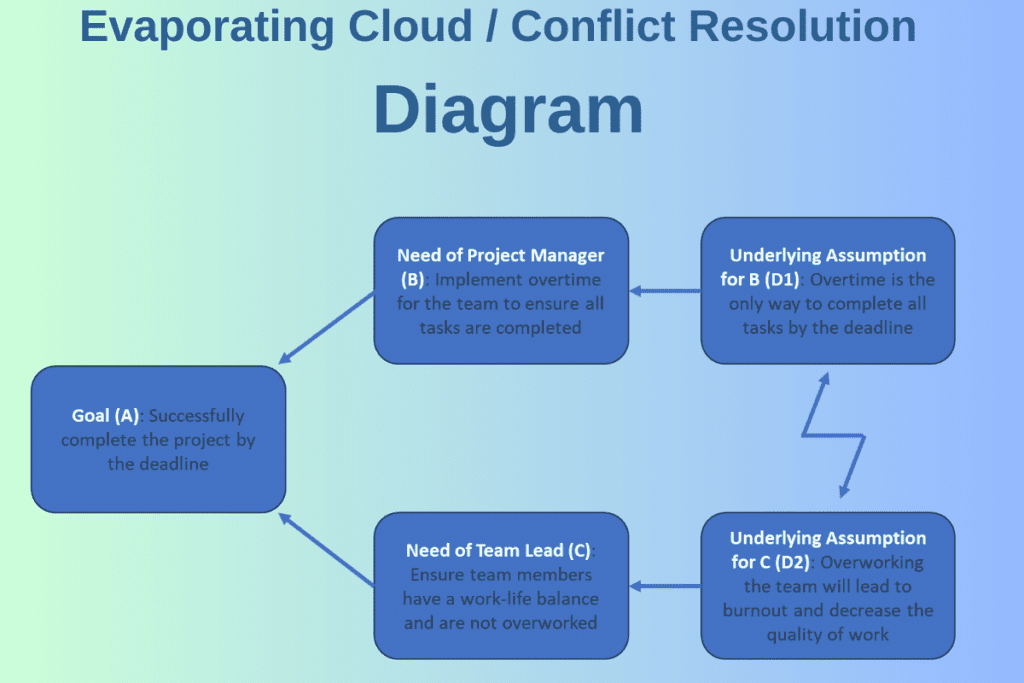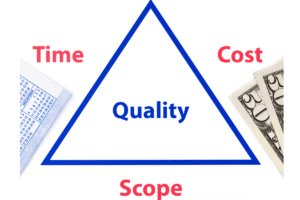Using the Evaporating Cloud: A Conflict Resolution Diagram
Dive deep into the realm of conflict resolution with the Evaporating Cloud, or EC for short, is a transformative tool rooted in the Thinking Process and Theory of Constraints. The EC, also known as a conflict cloud, is a robust tool based on the TOC thinking processes to resolve conflicts in organizations. It fundamentally offers a win-win solution to apparent conflicts, showcasing the logic behind dilemmas and the way to dissolve them.
Whether you’re navigating the intricate pathways of project management or striving for excellence in process improvement, this article offers a step-by-step guide to harnessing the power of the Evaporating Cloud. Unravel the mysteries behind this technique and discover how it can be your compass in the journey toward effective conflict resolution and organizational success.
The Evaporating Cloud
What is the Evaporating Cloud?
The evaporating cloud is a conflict resolution diagram introduced by Eliyahu M. Goldratt. It’s a tool to surface and resolve conflicts or dilemmas in any organizational setting, encouraging a broad vision of the current reality. The term ‘cloud’ symbolizes the obscure view of the conflict with one another, whereas ‘evaporation’ signifies the clarification process.
How does the Evaporating Cloud work?
This tool is designed to address conflict or dilemma situations.
Its four-step process works by:
- Identifying the core conflict
- Surfacing the underlying assumptions
- Validating those assumptions
- Resolving the conflict
It employs the logical thinking process to facilitate clarity. The diagram displays the assumptions as arrows pointing from one dilemma to another.
Benefits of using the Evaporating Cloud
EC is renowned for its effectiveness in problem solving, conflict management, and understanding different perspectives resulting in win-win solutions. EC allows the creation of a visible ‘conflict cloud’ showing the constraints, assumptions, and erroneous assumptions within the current reality. The process leads to removing barriers to success and achieving the common objective.
 The Conflict Resolution Diagram
The Conflict Resolution Diagram
Understanding the Conflict Resolution Diagram
The Conflict Resolution Diagram is a powerful thinking tool used in support of conflict resolution. Its logical structure unveils the underlying assumptions that support the conflict. Dettmer, Scheinkopf and Fedurko are some of the key contributors in refining this diagram from the TOC perspective.
Steps to resolve conflicts using the Conflict Resolution Diagram
Step 1: Identify the core conflict
Begin by identifying the primary issue, the central conflict that is restraining the common objective. Known as a conflict, it often stems from a constraint regarding customers, resources, or policies.
Step 2: Surface the underlying assumptions
The conflict resolution diagram allows us to surface the underlying assumptions. These are the taken-for-granted beliefs that are often not explicit but form the foundation of the identified conflict.
Step 3: Validate the assumptions
The next process is to validate these assumptions. In the context of TOC, this step involves using the “Current Reality Tree” (CRT) to prove or disprove the assumptions.
Step 4: Generate and evaluate solutions
The final step creates a space for injecting new solutions, therefore leading to the “evaporation” of the conflict. The solution, ideally, needs to be a win-win outcome satisfying all parties involved.
Using the Evaporating Cloud in Project Management
The role of the Evaporating Cloud in project management
The EC plays a vital role in project management, offering a structured way to address conflicts or dilemmas. Specifically, putting the TOC thinking processes to use in this context leads to project efficiency and provides a tool for conflict resolution and problem solving.
How to set up and use the Evaporating Cloud in project management
Setting up the EC begins by defining the common objective within the project framework and progressively moves along the steps. It results in demystifying conflicts, seeing the logic behind, and manifesting a benchmark for project success and constraint management.
Using the Evaporating Cloud in Process Improvement
The role of the Evaporating Cloud in process improvement
In process improvement, the cloud is the tool of choice for pinpointing and resolving conflicts as it unveils bottlenecks in processes, leading to increased efficiency.
How to set up and use the Evaporating Cloud in process improvement
The initial step is to identify the problematic constraint, followed by revealing assumptions, validating the theory, and generating solutions. This straightforward process leads to optimized operations and expedited improvement.
Conclusion
Overall, the Evaporating Cloud is an effective tool for conflict resolution in both project management and process improvement scenarios. With a blend of logical thinking and the Theory of Constraints thinking, the evaporating cloud makes conflict resolution an achievable goal rather than an intimidating hurdle. Regardless of the setting, it encourages win-win scenarios – a true game-changer for businesses today.
If you liked this article, remember to subscribe to MiamiCloud.com. Connect. Learn. Innovate.






